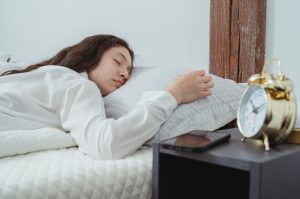WOMEN AND SLEEP
Do any of these sound familiar to American women?
Is night time sleep becoming a lost skill?
Is fibromyalgia by day likening to useless sleep by night?
Is menopause and weight gain causing snoring and sleeplessness?

Women are susceptible to sleep disturbances in each phase of life. During the early adult years, there are hormonal variations that make certain times in the month, generally just before or at the start of menses, a time for excess sleepiness. Assuming multiple roles, the average working woman with a family is sleeping less than 7 hours on most weekday nights, compared to 19th century women who slept 9 hours or more a night. Thus, the commonest sleep disorder in younger women, experienced by nearly half, is insufficient sleep.
During and after menopause, women increasingly notice they are not sleeping well. Problems of getting to sleep and staying asleep occur in 15% of younger adults of either gender, but only women undergo a drastic increase in insomnia as midlife proceeds, peaking at 35% after retirement. Use of hormone replacement therapy (HRT), which helped to eliminate hot flashes and thus restored the sleep in some affected women, has dropped significantly in recent years after two major studies, the Women’s Health Initiative and the Heart and Estrogen/Progestin Replacement Study, showed no cardiac benefit and a greater risk of breast cancer from use of HRT. After eliminating psychologic and medical reasons for sleep difficulties, the treatment of insomnia symptoms involves cognitive and pharmacologic approaches.
Fibromyalgia, a multiple system syndrome involving soft tissue pain, irritable bowel symptoms, depression and fatigue, is much more common in women than men by a ratio of 7 to 1. The syndrome has come to be regarded as a legitimate rheumatologic condition. Part of what has established its legitimacy is the discovery of a bona fide brain wave (EEG) abnormality interrupting the sleep of many persons with fibromyalgia. This EEG pattern lessens the effectiveness of the sleep and results in a generalized feeling of fatigue in the fibromyalgia sufferer during the day. Treatment of the sleep helps the fibromyagia symptoms and vice versa: less pain means better sleep.
Weight gain is common in menopause, and added weight along with its redistribution may cause circumferential narrowing in the pharynx that is associated with obstructive sleep apnea (OSA). While OSA is much more common in men than women during middle age working years (24% vs. 9%), after menopause, the incidence in women almost catches up with men in its frequency. Snoring is quite common in association with sleep apnea but its absence does not guarantee there is no breathing disturbance. Nearly 50% of men and women snore by the age of 65, and a large portion of snorers have sleep apnea.
A new awareness of the high frequency of sleep apnea among stroke and heart failure patients, more than half of whom are women after the age of 80, has led to further need for identifying and treating this condition. Research has demonstrated that treating apnea leads to lowering of elevated blood pressure, lessening of care dependency after a major stroke, and improved quality of life in heart failure patients.
Recent research on sleep in women has led to important discoveries about why more women than men suffer with sleep disorders. The effects of the female hormones and their absence during and after menopause, societal trends, and much improved survival after treatment for cardiac problems has exposed longer living women to common but treatable sleep disturbances. The insomnia experience of older women can be addressed. If you are a woman with a sleep disturbance, you shouldn’t have to endure chronic fatigue. Address your quality of life shortfall by seeing your primary physician or a sleep specialist to determine the cause and treat it.
References
Byles JE, Mishra GD, & Harris MA: The experience of insomnia among
older women. Sleep 2005; 28(8): 972-9.
Eichling PS & Sahni J Menopause related sleep disorders. J Clin
Slp Med 2005; 1(3): 291-300.
Dzala A, Arber S & Hislop J et al. Women’s sleep in health and disease.
J Pschiatr res 2005; 39:55-76.
Turek FW Gender (Sex) and sleep: shh..not in front of the children.
Sleep 2006; 29(1): 21-2.
Zhang B & Wing YK Sex differences in insomnia: a meta-analysis
Sleep 2006: 29(1): 85-93.
Dijk DJ Sleep of aging women and men: back to basics.
Sleep 2006; 29(1): 12-13.
Latta F, Leproult R, et al. Sex differences in nocturnal growth hormone
and prolactin secretion in healthy older adults. Sleep 2005; 28(12):
1519-24.
Latta F , Leproult R et al. Sex differences in delta and alpha EEG
activities in healthy older adults. Sleep 2005; 28(12): 1525-34.
Armitage R, Baker FC, & Parry BL “The menstrual cycle and circadian
rhythms” in Kryger, Roth, and Dement, eds. Principles and Practice
of Sleep Medicine. Elsevier Saunders Pub. 2005, pp 1266-77
Turkington PM & Elliott MW. Sleep disordered breathing following
stroke . Slp Diag & Ther 2006; 1(2): 52-5.
Good D et al. Sleep disordered breathing and poor functional outcome
after stroke. Stroke 1996; 27:252-9
Turkington PM et al. Effect of upper airway obstruction in acute stroke on
functional outcome at 6 months. Thorax, 2004; 59:367-71.
National Sleep Foundation, Women & Sleep, CFC# 2697, 2004

